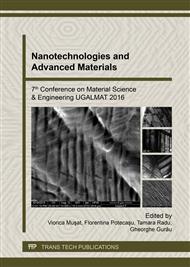p.91
p.97
p.103
p.108
p.114
p.120
p.127
p.133
p.139
Properties of Alkali Activated Ground Granulated Blast Furnace Slag Based Geopolymers
Abstract:
Ground granulated blast furnace slag, red mud, wheat straw ash are secondary material which after alkaline activation can be used in the construction materials’ domain. Their disposal poses a threat to the environment, whereas by reusing them we would be able to reduce this negative impact. This paper describes the research carried out in order to synthesise some geopolymer recipes, which are based on ground granulated blast furnace slag, red mud and wheat straw ash, alkaline activated with sodium hydroxide or a solution made with sodium hydroxide and sodium silicate. Factors that influence the compression strength have been studied such as: the nature of the alkaline activator, the chemical composition of solid materials in the recipes and the curing time. The geopolymer samples have been dried at room temperature for 7 and 28 days, respectively, and after the compressive strength tests has been made. Following this research it has been found out that NaOH/Na2SiO3 activated geopolymer samples have shown a higher resistance in the compressive strength. From the SEM analysis it has been found out that the samples with a higher amount of ground granulated blast furnace slag in their composition had a more homogeneous and less porous design than those with a smaller amount of ground granulated blast furnace slag.
Info:
Periodical:
Pages:
114-119
Citation:
Online since:
February 2017
Authors:
Keywords:
Price:
Сopyright:
© 2017 Trans Tech Publications Ltd. All Rights Reserved
Share:
Citation:


